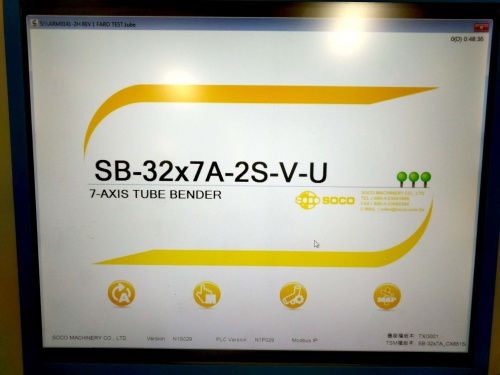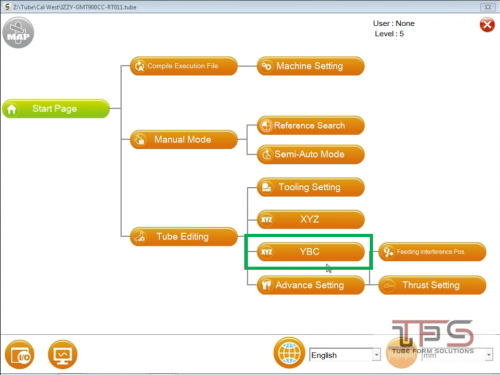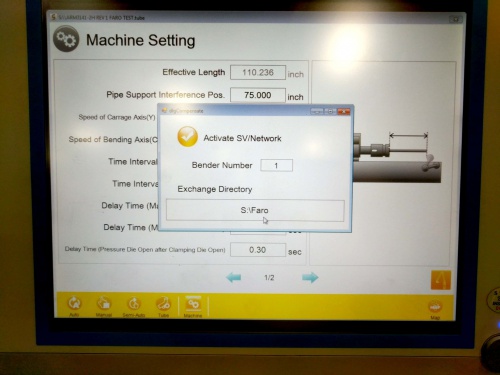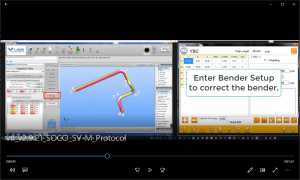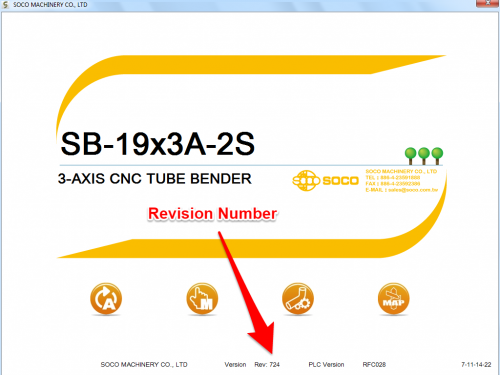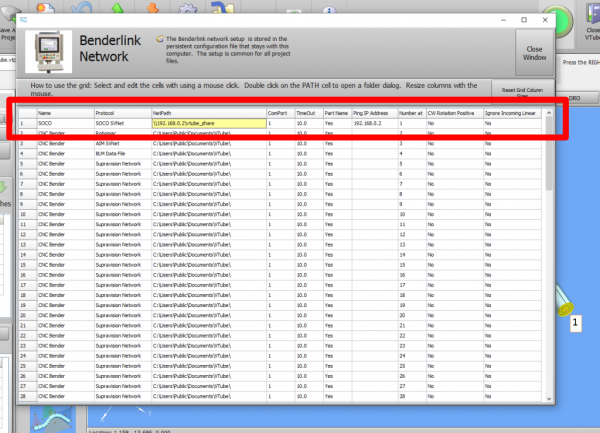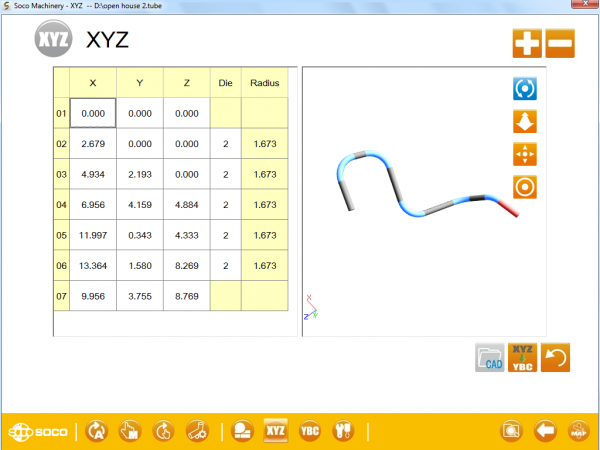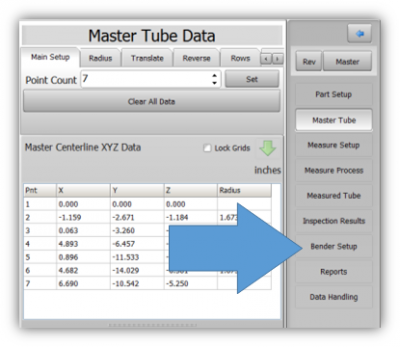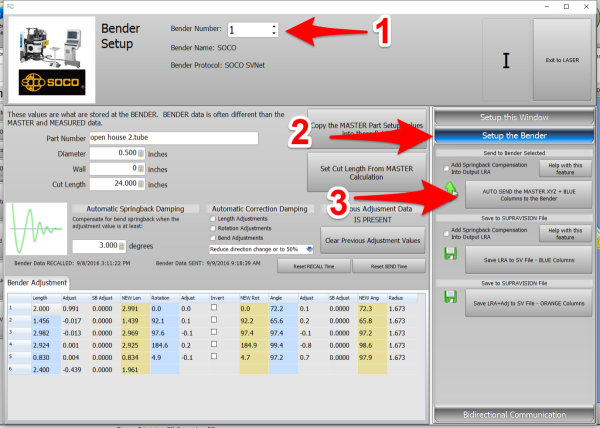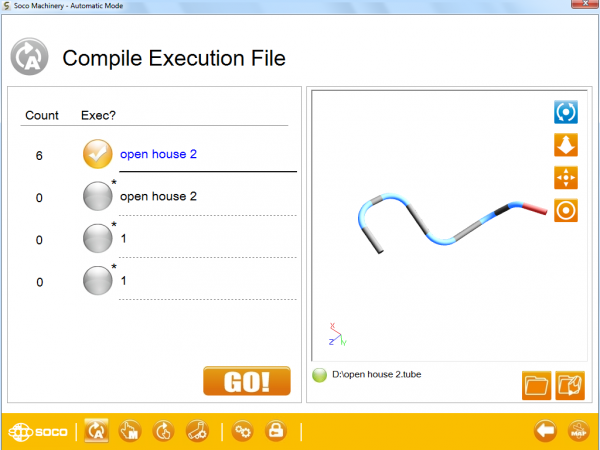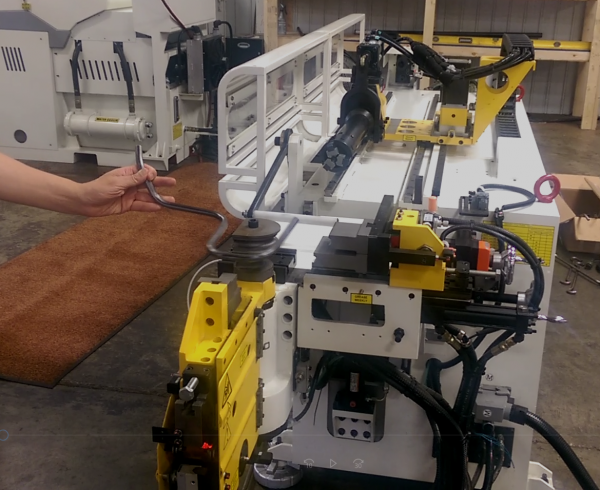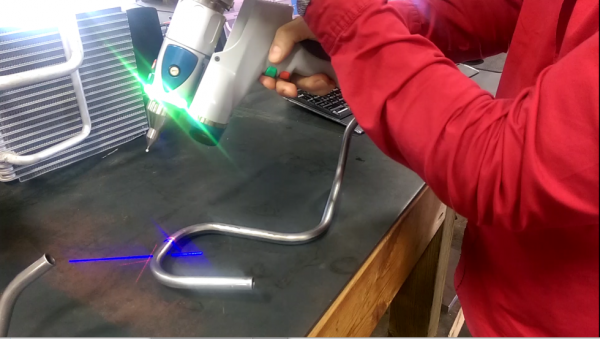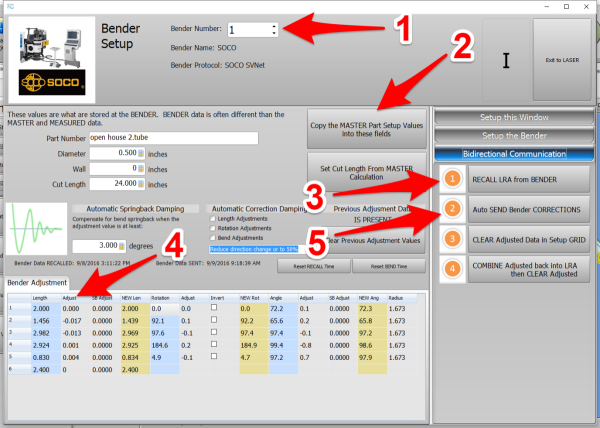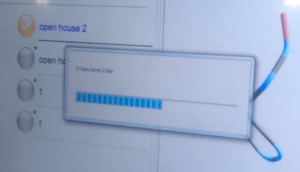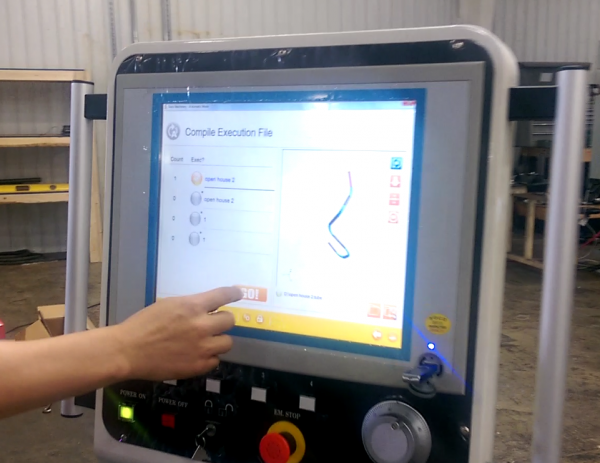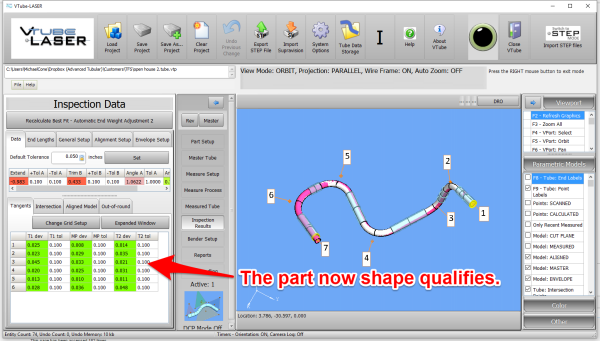Difference between revisions of "VTube Communication for SOCO"
(→VTube Computer) |
(→Video: Send NEW Parts to SOCO Beckhoff Controls) |
||
| (137 intermediate revisions by one user not shown) | |||
| Line 5: | Line 5: | ||
This page describes the setup and use of the VTube to SOCO communications.<br><br> | This page describes the setup and use of the VTube to SOCO communications.<br><br> | ||
The distributor of SOCO benders is TFS - Tube Form Solutions in Elkhart, Indiana.<br><br> | The distributor of SOCO benders is TFS - Tube Form Solutions in Elkhart, Indiana.<br><br> | ||
| − | [[image:TFS Logo.png]] | + | [[image:TFS Logo.png|250px]] |
</td> | </td> | ||
<td width=500> | <td width=500> | ||
| − | [[image:SOCO Logo with Bender.png| | + | [[image:SOCO Logo with Bender.png|250px]]<br> |
</td> | </td> | ||
</tr> | </tr> | ||
</table> | </table> | ||
| − | + | __TOC__ | |
| − | == | + | ==Communications for Two SOCO Control Types== |
<table width=1000> | <table width=1000> | ||
<tr valign=top> | <tr valign=top> | ||
<td width=300> | <td width=300> | ||
| − | + | ||
| + | <b>Note: There are two control types that operate differently. They are referred to as Mitsubishi type and Beckhoff type. There are sections for both below.</b> | ||
| + | |||
| + | If you have any questions, please contact [mailto:[email protected] Michael Cone at Advanced Tubular Technologies], or [mailto:[email protected] Kyle Eagle at TFS] (Tube Form Solutions - Distributor for SOCO).<br><br> | ||
| + | See [http://www.advancedtubular.wiki/index.php/VTube-LASER_Videos#Video_62:_Setup_and_Correct_SOCO_Benders_with_VTube-LASER_Communications Video 62 - SOCO Communications Video] to see an actual corrections loop with a Mitsubilisy-based SOCO bender. | ||
</td> | </td> | ||
<td width=500> | <td width=500> | ||
| Line 26: | Line 30: | ||
</table> | </table> | ||
| − | ==Protocol== | + | |
| + | |||
| + | <br><br> | ||
| + | |||
| + | ---- | ||
| + | |||
| + | <br><br> | ||
| + | |||
| + | <br><br> | ||
| + | |||
| + | =SECTION FOR BECKHOFF CONTROL TYPES= | ||
| + | |||
| + | ==SOCO SV-M Protocol (Beckhoff Type Controls)== | ||
| + | |||
<table> | <table> | ||
<tr valign=top> | <tr valign=top> | ||
<td width=300> | <td width=300> | ||
| − | [[VTube-STEP]] can export Supravision | + | [[VTube-STEP]] can export NEW Supravision files that this control can load. In the part load section of this control, just choose any file with the $$$ filename extension, and the control will know that it is a new Supravision file to load.<br><br> |
| − | [[VTube-LASER]], the version of VTube that connects to a | + | [[VTube-LASER]], the version of VTube that connects to a portable measuring center arms, can send measured data to the SOCO control for corrections.<br><br> |
| − | + | ||
</td> | </td> | ||
<td width=300> | <td width=300> | ||
| − | [[image: | + | [[image:SOCO SV-M.png|300px]] |
</td> | </td> | ||
</tr> | </tr> | ||
</table> | </table> | ||
| − | ==Communications Setup at the SOCO Bender== | + | ==Sending a NEW Part to the SOCO Bender (Beckhoff Type Controls)== |
| + | <table> | ||
| + | |||
| + | <tr valign=top> | ||
| + | <td width=500> | ||
| + | * Connect the SOCO bender to the network using a standard Ethernet cable. Usually, SOCO computers can be accessed through the lower front of the operator station. Run the cable through the small side door on the right, and up to the computer system. The SOCO control computer will have Ethernet ports available for connection.<br><br> | ||
| + | * Setup a shared network location either in the SOCO windows control or in a network path on your network.<br><br> | ||
| + | * From VTube-STEP or VTube-LASER, save a Supravision file for the new part you want to send to the SOCO in that network location.<br><br> | ||
| + | * In the SOCO Startup Screen, press the MAP button.<br><br> | ||
| + | </td> | ||
| + | <td width=300> | ||
| + | [[image:Soco Beckhoff Startup Screen.jpg|500px]]<br><br> | ||
| + | </td> | ||
| + | </tr> | ||
| + | |||
| + | <tr valign=top> | ||
| + | <td width=500> | ||
| + | * In the SOCO MAP screen, press the YBC button.<br><br> | ||
| + | </td> | ||
| + | <td width=300> | ||
| + | [[image:Soco Beckhoff Main Screen Press YBC.png|500px]] | ||
| + | </td> | ||
| + | </tr> | ||
| + | |||
| + | <tr valign=top> | ||
| + | <td width=500> | ||
| + | * In the SOCO YBC screen, press the FILES button.<br><br> | ||
| + | </td> | ||
| + | <td width=300> | ||
| + | [[image:Soco Beckhoff YBC Files Button.png|500px]] | ||
| + | </td> | ||
| + | </tr> | ||
| + | |||
| + | <tr valign=top> | ||
| + | <td width=500> | ||
| + | * Press the OPEN FOLDER button.</td> | ||
| + | <td width=300> | ||
| + | [[image:Soco Beckhoff YBC Open Folder Icon.png|500px]] | ||
| + | </td> | ||
| + | </tr> | ||
| + | |||
| + | <tr valign=top> | ||
| + | <td width=500> | ||
| + | * Browse to the Supravision file. (The SOCO will show a "T" icon for a Supravision file. SOCO knows that this is a Supravision file because it has a $$$ filename extension. VTube also uses this same extension when exporting Supravision files.)<br><br> | ||
| + | * Press the CONFIRM button.<br><br> | ||
| + | * The new nominal YBC data will display on the screen.</td> | ||
| + | <td width=300> | ||
| + | [[image:Soco Beckhoff YBC Browse to Supravision File.png|500px]] | ||
| + | </td> | ||
| + | </tr> | ||
| + | |||
| + | |||
| + | |||
| + | </table> | ||
| + | |||
| + | ====Video: Send NEW Parts to SOCO Beckhoff Controls==== | ||
| + | |||
| + | <table width=1000> | ||
| + | <tr> | ||
| + | <td width=500> | ||
| + | You can also see a video of this process in a video in our SOCO video library.<br><br> | ||
| + | </td> | ||
| + | <td> | ||
| + | * See videos in the [https://advancedtubular.exavault.com/share/view/2ygxc-740lqiyh SOCO Video Library] | ||
| + | </td> | ||
| + | |||
| + | </tr> | ||
| + | </table> | ||
| + | <br><br> | ||
| + | |||
| + | |||
| + | |||
| + | |||
| + | <br><br><br> | ||
| + | |||
| + | ==How to Set Up and Use a Corrections Loop at the SOCO Bender (Beckhoff Type Controls)== | ||
| + | <table> | ||
| + | |||
| + | <tr valign=top> | ||
| + | <td width=500> | ||
| + | * Connect the SOCO bender to the network using a standard Ethernet cable. Usually, SOCO computers can be accessed through the lower front of the operator station. Run the cable through the small side door on the right, and up to the computer system. The SOCO control computer will have Ethernet ports available for connection.<br><br> | ||
| + | * Setup a shared network location either in the SOCO windows control or in a network path on your network.<br><br> | ||
| + | * In the SOCO Startup Screen, press the MAP button.<br><br> | ||
| + | </td> | ||
| + | <td width=300> | ||
| + | [[image:Soco Beckhoff Startup Screen.jpg|500px]]<br><br> | ||
| + | </td> | ||
| + | </tr> | ||
| + | |||
| + | <tr valign=top> | ||
| + | <td width=500> | ||
| + | * In the SOCO MAP screen, press the Machine Setting button.<br><br> | ||
| + | </td> | ||
| + | <td width=300> | ||
| + | [[image:Soco Beckhoff Main Screen Press Macihne Setting.jpg|500px]] | ||
| + | </td> | ||
| + | </tr> | ||
| + | |||
| + | <tr valign=top> | ||
| + | <td width=500> | ||
| + | * In the SOCO Machine Setting screen, press the measuring center button.<br><br> | ||
| + | </td> | ||
| + | <td width=300> | ||
| + | [[image:Soco Beckhoff Machine Setting Press Measuring Center Icon.jpg|500px]] | ||
| + | </td> | ||
| + | </tr> | ||
| + | |||
| + | <tr valign=top> | ||
| + | <td width=500> | ||
| + | * Enter the shared network path in the Exchange Directory field. This path name cannot be a UNC name (like \\192.168.0.2\VTube\). It must be a path with a drive and a path that follows. If you must network to a location on the network, then map a drive letter to that location, and use the mapped drive letter in this field.<br><br> | ||
| + | * Enter the bender number. Each bender number needs to have a unique number in the network. The bender number must be 1 or higher. Don't use "0" for the bender number, because VTube requires a bender number that is at least 1. | ||
| + | </td> | ||
| + | <td width=300> | ||
| + | [[image:Soco Beckhoff Machine Setting Activate SVnetwork.jpg|500px]] | ||
| + | </td> | ||
| + | </tr> | ||
| + | |||
| + | |||
| + | </table> | ||
| + | |||
| + | <br><br><br> | ||
| + | |||
| + | ====Video: Corrections Loop with SOCO Beckhoff Controls==== | ||
| + | |||
| + | <table width=1000> | ||
| + | <tr> | ||
| + | <td width=500> | ||
| + | This demo video shows how VTube-LASER performs corrections loop communications with SOCO Beckhoff controls. | ||
| + | </td> | ||
| + | <td width=300> | ||
| + | [[image:vtubelaser_v2.9.21.video_soco_beckhoff_communications.png|300px]]<br> | ||
| + | </td> | ||
| + | <td width=300> | ||
| + | * View [https://vimeo.com/356003359 Vimeo] | ||
| + | * View [https://www.advancedtubular.com/vtube-laser/vtl_v2.9.21_SOCO_SV-M_Protocol.mp4 MP4] | ||
| + | </td> | ||
| + | </tr> | ||
| + | |||
| + | </table> | ||
| + | <br><br> | ||
| + | |||
| + | ==How to SEND CORRECTION Data to the Beckhoff SOCO Control from VTube-LASER== | ||
| + | <table> | ||
| + | <tr valign=top> | ||
| + | <td width=300> | ||
| + | [[VTube-LASER]], the version of VTube that connects to a portable measuring center arms, can send measured data to the SOCO control for corrections from the Bender Setup screen.<br><br> | ||
| + | Enter that screen and press Auto SEND. In this protocol, VTube-LASER sends the MEASURED data in the Supravision file.<br><br> | ||
| + | </td> | ||
| + | <td width=300> | ||
| + | [[image:VTube-LASER to Soco SV-M.png|500px]] | ||
| + | </td> | ||
| + | </tr> | ||
| + | </table> | ||
| + | |||
| + | ==How to IMPORT CORRECTION Data in the Beckhoff SOCO Control from VTube-LASER== | ||
| + | <table> | ||
| + | <tr valign=top> | ||
| + | <td width=300> | ||
| + | At the SOCO bender, in the YBC screen, press the measuring center and import the $$$ file that was saved. The filename will have this form: SOCO-M001.$$$, or SOCO-M002.$$$, or SOCO-M003.$$$, etc., depending on the bender number.<br><br> | ||
| + | Load that file and the SOCO will adjust the compensation data. | ||
| + | </td> | ||
| + | <td width=300> | ||
| + | </td> | ||
| + | </tr> | ||
| + | </table> | ||
| + | |||
| + | |||
| + | <br><br> | ||
| + | <br><br> | ||
| + | |||
| + | <br><br> | ||
| + | |||
| + | ---------- | ||
| + | |||
| + | <br><br> | ||
| + | |||
| + | <br><br> | ||
| + | |||
| + | =SECTION FOR MITSUBISHI CONTROL TYPES= | ||
| + | |||
| + | ==SOCO SVNET Protocol (Mitsubishi Type Controls)== | ||
| + | <table> | ||
| + | <tr valign=top> | ||
| + | <td width=300> | ||
| + | [[VTube-STEP]] can export Supravision data to Mitsubishi-based SOCO benders using the SOCO SVNet protocol.<br><br> | ||
| + | [[VTube-LASER]], the version of VTube that connects to a portable measuring center arms, can send measured data to the SOCO control for corrections.<br><br> | ||
| + | </td> | ||
| + | <td width=300> | ||
| + | [[image:VTube-LASER to Soco XYZ.png|500px]] | ||
| + | </td> | ||
| + | </tr> | ||
| + | </table> | ||
| + | |||
| + | ==Communications Setup at the SOCO Bender (Mitsubishi Type Controls)== | ||
<table> | <table> | ||
<tr valign=top> | <tr valign=top> | ||
| Line 61: | Line 270: | ||
</table> | </table> | ||
| − | ==Setup Benderlink at VTube-STEP or VTube-LASER== | + | ==Setup Benderlink at VTube-STEP or VTube-LASER for Communications with Mitsubishi-based SOCO== |
===Entering Benderlink Setup=== | ===Entering Benderlink Setup=== | ||
<table> | <table> | ||
<tr valign=top> | <tr valign=top> | ||
| − | <td width= | + | <td width=300> |
#Enter the VTube System Options menu.<br><br> | #Enter the VTube System Options menu.<br><br> | ||
#Enter the Measure 2 tab menu.<br><br> | #Enter the Measure 2 tab menu.<br><br> | ||
| Line 78: | Line 287: | ||
===Setup the Benderlink Network Grid for the SOCO Bender=== | ===Setup the Benderlink Network Grid for the SOCO Bender=== | ||
| − | <table> | + | <table cellpadding=10> |
<tr valign=top> | <tr valign=top> | ||
| − | <td width= | + | <td width=300> |
#Choose an unused row in the grid for a new SOCO bender setup. (Click on the image at the right to see a zoomed image.)<br><br> | #Choose an unused row in the grid for a new SOCO bender setup. (Click on the image at the right to see a zoomed image.)<br><br> | ||
#Assign a bender name that will help operators identify what this bender is. This text will be displayed at the top of the Bender Setup menu.<br><br> | #Assign a bender name that will help operators identify what this bender is. This text will be displayed at the top of the Bender Setup menu.<br><br> | ||
| Line 96: | Line 305: | ||
</table> | </table> | ||
| − | ==How to SEND MASTER XYZ Data to the SOCO Control from VTube-STEP== | + | ==How to SEND MASTER XYZ Data to the Mitubishi SOCO Control from VTube-STEP == |
<table cellpadding=10> | <table cellpadding=10> | ||
<tr valign=top> | <tr valign=top> | ||
| Line 102: | Line 311: | ||
You can import data into VTube-STEP then send the XYZ Centerline data calculated to the SOCO bender using the VTube Bender Output menu.<br><br> | You can import data into VTube-STEP then send the XYZ Centerline data calculated to the SOCO bender using the VTube Bender Output menu.<br><br> | ||
| − | === | + | ===Show the XYZ Screen at the SOCO Control=== |
| − | At the SOCO control, | + | At the SOCO control, to receive NEW data, <b>you must be in the SOCO XYZ screen</b>. |
| + | |||
| + | With the XYZ Screen open, the SOCO control will understand that it must extract the MASTER XYZ data in the incoming data and import that into the SOCO NVS software.<br><br> | ||
| + | |||
| + | Notes: | ||
| + | |||
| + | 1) | ||
| + | |||
</td> | </td> | ||
<td width=400> | <td width=400> | ||
| Line 116: | Line 332: | ||
<td width=300> | <td width=300> | ||
| − | ===At the VTube Computer=== | + | ===At the VTube-STEP Computer=== |
Move to the VTube-STEP computer and follow these steps to transfer the XYZ data to the SOCO. | Move to the VTube-STEP computer and follow these steps to transfer the XYZ data to the SOCO. | ||
| Line 123: | Line 339: | ||
# Press the Send to Bender button. | # Press the Send to Bender button. | ||
<br> | <br> | ||
| − | + | The SOCO will receive new data and ask if it should be imported with a dialog. Press YES to import the data. | |
</td> | </td> | ||
<td width=400> | <td width=400> | ||
| Line 134: | Line 350: | ||
<br><br> | <br><br> | ||
| − | ==How to SEND MASTER XYZ Data to the SOCO Control from VTube-LASER== | + | ==How to SEND MASTER XYZ Data to the Mitsubishi SOCO Control from VTube-LASER== |
<table cellpadding=10> | <table cellpadding=10> | ||
<tr valign=top> | <tr valign=top> | ||
| Line 141: | Line 357: | ||
You can also send the new XYZ Centerline data from the VTube-LASER BENDER SETUP menu to the SOCO bender using the VTube Bender Output menu.<br><br> | You can also send the new XYZ Centerline data from the VTube-LASER BENDER SETUP menu to the SOCO bender using the VTube Bender Output menu.<br><br> | ||
| − | + | ===Enter the XYZ Screen At the SOCO Control=== | |
| − | + | At the SOCO control, enter the XYZ Screen. With the XYZ Screen open, the SOCO control will understand that it must extract the MASTER XYZ data in the incoming data and import that into the SOCO NVS software.<br><br> | |
| + | </td> | ||
| + | <td width=400> | ||
| + | [[image:socoXYZscreen.png|600px]] | ||
| + | </td> | ||
| + | </tr> | ||
| + | </table> | ||
| − | + | <table cellpadding=10> | |
| − | + | <tr valign=top> | |
| − | + | <td width=300> | |
| − | + | ||
| − | + | ===Enter the BENDER SETUP menu in VTube-LASER=== | |
| − | + | Follow these steps in the VTube-LASER: | |
| + | |||
| + | Press the "BENDER SETUP button in the Navigation Pane. | ||
</td> | </td> | ||
<td width=400> | <td width=400> | ||
| + | [[image:vtube-laser_2.7_bendersetup_button_navigationpane.png|400px]]<br><br> | ||
| + | </td> | ||
| + | </tr> | ||
| + | </table> | ||
| − | + | <table cellpadding=10> | |
| + | <tr valign=top> | ||
| + | <td width=300> | ||
| + | STEP 1 - Set the correct bender number at the top of the window. As of version 2.7, the SOCO SVNet option is available - which means you should see a SOCO bender at the top left corner of the screen. | ||
| − | |||
| + | STEP 2 - On the right click on "Setup the Bender". | ||
| + | |||
| + | STEP 3 - Click on AUTO SEND | ||
| + | <br><br> | ||
| + | The SOCO will receive new data and ask if it should be imported with a dialog. Press YES to import the data. | ||
| + | </td> | ||
| + | <td width=400> | ||
| + | [[image:vtube-laser_v2.7_send_master_to_soco.png|600px]] | ||
</td> | </td> | ||
</tr> | </tr> | ||
</table> | </table> | ||
| + | |||
| + | |||
| + | <br><br> | ||
| + | |||
| + | ==How to SEND CORRECTION Data to the Mitsubishi SOCO Control from VTube-LASER== | ||
| + | <table cellpadding=10> | ||
| + | <tr valign=top> | ||
| + | <td width=300> | ||
| + | |||
| + | ===At the SOCO Control=== | ||
| + | At the SOCO control, setup and bend the first tube through the YBC and then Compile Execution screen.<br><br> | ||
| + | </td> | ||
| + | <td width=400> | ||
| + | [[image:soco_compile_execution_screen.png|600px]] | ||
| + | </td> | ||
| + | </tr> | ||
| + | </table> | ||
| + | |||
| + | <table cellpadding=10> | ||
| + | <tr valign=top> | ||
| + | <td width=300> | ||
| + | |||
| + | ===After Bending the Tube=== | ||
| + | After the bending cycle is complete, remove the tube from the dies. Leave the bender in AUTO mode.<br><br> | ||
| + | </td> | ||
| + | <td width=400> | ||
| + | [[image:soco_remove_part_from_bender.png|600px]] | ||
| + | </td> | ||
| + | </tr> | ||
| + | </table> | ||
| + | |||
| + | |||
| + | <table cellpadding=10> | ||
| + | <tr valign=top> | ||
| + | <td width=300> | ||
| + | |||
| + | ===Measure the tube with VTube-LASER=== | ||
| + | Measure and align the tube to determine if it qualifies by falling within the envelope tolerance for the tube shape. | ||
| + | <br><br> | ||
| + | In the VTube-LASER screen shot, you see the actual result of the first tube not qualifying in shape. The red cells in the tangent point grid on the lower left show that the measured tube centerline is out-of-tolerance. | ||
| + | </td> | ||
| + | <td width=400> | ||
| + | [[image:vtube-laser_v2.7_soco_part_measure.png|600px]]<br><br> | ||
| + | [[image:vtube-laser_v2.7_soco_out_of_tolerance.png|600px]]<br><br> | ||
| + | </td> | ||
| + | </tr> | ||
| + | </table> | ||
| + | |||
| + | |||
| + | |||
| + | <table cellpadding=10> | ||
| + | <tr valign=top> | ||
| + | <td width=300> | ||
| + | |||
| + | ===Correct the SOCO with VTube-LASER - Enter BENDER SETUP=== | ||
| + | Follow these steps in the VTube-LASER: | ||
| + | |||
| + | Press the "BENDER SETUP button in the Navigation Pane. | ||
| + | </td> | ||
| + | <td width=400> | ||
| + | [[image:vtube-laser_2.7_bendersetup_button_navigationpane.png|400px]]<br><br> | ||
| + | </td> | ||
| + | </tr> | ||
| + | </table> | ||
| + | |||
| + | <table cellpadding=10> | ||
| + | <tr valign=top> | ||
| + | <td width=300> | ||
| + | |||
| + | ===RECALL SOCO YBC data and then SEND CORRECTIONS=== | ||
| + | STEP 1 - Set the correct bender number at the top of the window. As of version 2.7, the SOCO SVNet option is available - which means you should see a SOCO bender at the top left corner of the screen. | ||
| + | |||
| + | |||
| + | STEP 2 - If the Part Number is empty, then press the Copy the Master Part Setup values. | ||
| + | |||
| + | |||
| + | STEP 3 - Click on RECALL. This will update the BLUE columns in the Bender Setup. | ||
| + | |||
| + | |||
| + | STEP 4 - You can manually change the ADJUSTMENT values before sending corrections. In this case, we set the first and last Length adjustment to zero in order to keep the start position of the carriage in the same place. | ||
| + | |||
| + | |||
| + | STEP 5 - Click on AUTO SEND. This will send the ORANGE columns to the SOCO bender. | ||
| + | </td> | ||
| + | <td width=400> | ||
| + | [[image:vtube-laser_v2.7_soco_send_correction.png|600px]] | ||
| + | </td> | ||
| + | </tr> | ||
| + | </table> | ||
| + | |||
| + | |||
| + | <table cellpadding=10> | ||
| + | <tr valign=top> | ||
| + | <td width=300> | ||
| + | |||
| + | ===At the SOCO Bender - Press GO!=== | ||
| + | Press GO! The SOCO will compile the changes. | ||
| + | |||
| + | You will see a progress bar after you press GO! | ||
| + | <br><br> | ||
| + | [[image:soco_press_go_compile_execution_progressbar.png|300px]] | ||
| + | </td> | ||
| + | <td width=400> | ||
| + | [[image:soco_press_go_compile_execution.png|600px]] | ||
| + | </td> | ||
| + | </tr> | ||
| + | </table> | ||
| + | |||
| + | <table cellpadding=10> | ||
| + | <tr valign=top> | ||
| + | <td width=300> | ||
| + | |||
| + | The "Auto Compensation Completed" message will appear in the lower right corner. | ||
| + | |||
| + | Bend the corrected part now. | ||
| + | </td> | ||
| + | <td width=400> | ||
| + | [[image:soco_auto_compensation_completed.png|600px]] | ||
| + | </td> | ||
| + | </tr> | ||
| + | </table> | ||
| + | |||
| + | <table cellpadding=10> | ||
| + | <tr valign=top> | ||
| + | <td width=300> | ||
| + | |||
| + | ===Measure at the VTube-LASER Computer=== | ||
| + | Measure and align the tube again to determine if it qualifies by falling within the envelope tolerance for the tube shape. | ||
| + | <br><br> | ||
| + | This screen shot shows an actual resulting change after the correction. | ||
| + | </td> | ||
| + | <td width=400> | ||
| + | [[image:vtube-laser_v2.7_soco_part_qualifies.png|600px]]<br><br> | ||
| + | </td> | ||
| + | </tr> | ||
| + | </table> | ||
| + | |||
| + | |||
<br><br> | <br><br> | ||
| Line 168: | Line 544: | ||
* See [[VTube-STEP]] | * See [[VTube-STEP]] | ||
* See [[SOCO]] for information on the SOCO benders | * See [[SOCO]] for information on the SOCO benders | ||
| + | * See [http://www.advancedtubular.wiki/index.php/VTube-LASER_Videos#Video_62:_Setup_and_Correct_SOCO_Benders_with_VTube-LASER_Communications Video 62 - SOCO Communications Video] to see an actual corrections loop with a SOCO bender. | ||
Latest revision as of 19:49, 3 May 2022
About this Page
|
This page describes the setup and use of the VTube to SOCO communications. |
Communications for Two SOCO Control Types
|
Note: There are two control types that operate differently. They are referred to as Mitsubishi type and Beckhoff type. There are sections for both below. If you have any questions, please contact Michael Cone at Advanced Tubular Technologies, or Kyle Eagle at TFS (Tube Form Solutions - Distributor for SOCO). |
SECTION FOR BECKHOFF CONTROL TYPES
SOCO SV-M Protocol (Beckhoff Type Controls)
|
VTube-STEP can export NEW Supravision files that this control can load. In the part load section of this control, just choose any file with the $$$ filename extension, and the control will know that it is a new Supravision file to load. |
Sending a NEW Part to the SOCO Bender (Beckhoff Type Controls)
|
|
|
|
|
|
|
|
|
Video: Send NEW Parts to SOCO Beckhoff Controls
|
You can also see a video of this process in a video in our SOCO video library. |
|
How to Set Up and Use a Corrections Loop at the SOCO Bender (Beckhoff Type Controls)
|
|
|
|
|
|
|
Video: Corrections Loop with SOCO Beckhoff Controls
|
This demo video shows how VTube-LASER performs corrections loop communications with SOCO Beckhoff controls. |
How to SEND CORRECTION Data to the Beckhoff SOCO Control from VTube-LASER
|
VTube-LASER, the version of VTube that connects to a portable measuring center arms, can send measured data to the SOCO control for corrections from the Bender Setup screen. |
How to IMPORT CORRECTION Data in the Beckhoff SOCO Control from VTube-LASER
|
At the SOCO bender, in the YBC screen, press the measuring center and import the $$$ file that was saved. The filename will have this form: SOCO-M001.$$$, or SOCO-M002.$$$, or SOCO-M003.$$$, etc., depending on the bender number. |
SECTION FOR MITSUBISHI CONTROL TYPES
SOCO SVNET Protocol (Mitsubishi Type Controls)
|
VTube-STEP can export Supravision data to Mitsubishi-based SOCO benders using the SOCO SVNet protocol. |
Communications Setup at the SOCO Bender (Mitsubishi Type Controls)
|
Setup Benderlink at VTube-STEP or VTube-LASER for Communications with Mitsubishi-based SOCO
Entering Benderlink Setup
|
Setup the Benderlink Network Grid for the SOCO Bender
|
How to SEND MASTER XYZ Data to the Mitubishi SOCO Control from VTube-STEP
|
You can import data into VTube-STEP then send the XYZ Centerline data calculated to the SOCO bender using the VTube Bender Output menu. Show the XYZ Screen at the SOCO ControlAt the SOCO control, to receive NEW data, you must be in the SOCO XYZ screen. With the XYZ Screen open, the SOCO control will understand that it must extract the MASTER XYZ data in the incoming data and import that into the SOCO NVS software. Notes: 1) |
At the VTube-STEP ComputerMove to the VTube-STEP computer and follow these steps to transfer the XYZ data to the SOCO.
|
How to SEND MASTER XYZ Data to the Mitsubishi SOCO Control from VTube-LASER
|
You can also send the new XYZ Centerline data from the VTube-LASER BENDER SETUP menu to the SOCO bender using the VTube Bender Output menu. Enter the XYZ Screen At the SOCO ControlAt the SOCO control, enter the XYZ Screen. With the XYZ Screen open, the SOCO control will understand that it must extract the MASTER XYZ data in the incoming data and import that into the SOCO NVS software. |
|
Follow these steps in the VTube-LASER: Press the "BENDER SETUP button in the Navigation Pane. |
|
STEP 1 - Set the correct bender number at the top of the window. As of version 2.7, the SOCO SVNet option is available - which means you should see a SOCO bender at the top left corner of the screen.
|
How to SEND CORRECTION Data to the Mitsubishi SOCO Control from VTube-LASER
At the SOCO ControlAt the SOCO control, setup and bend the first tube through the YBC and then Compile Execution screen. |
After Bending the TubeAfter the bending cycle is complete, remove the tube from the dies. Leave the bender in AUTO mode. |
Measure the tube with VTube-LASERMeasure and align the tube to determine if it qualifies by falling within the envelope tolerance for the tube shape.
|
Correct the SOCO with VTube-LASER - Enter BENDER SETUPFollow these steps in the VTube-LASER: Press the "BENDER SETUP button in the Navigation Pane. |
RECALL SOCO YBC data and then SEND CORRECTIONSSTEP 1 - Set the correct bender number at the top of the window. As of version 2.7, the SOCO SVNet option is available - which means you should see a SOCO bender at the top left corner of the screen.
|
At the SOCO Bender - Press GO!Press GO! The SOCO will compile the changes. |
|
The "Auto Compensation Completed" message will appear in the lower right corner. Bend the corrected part now. |
Measure at the VTube-LASER ComputerMeasure and align the tube again to determine if it qualifies by falling within the envelope tolerance for the tube shape.
|
Other Pages
- See VTube-LASER
- See VTube-STEP
- See SOCO for information on the SOCO benders
- See Video 62 - SOCO Communications Video to see an actual corrections loop with a SOCO bender.



